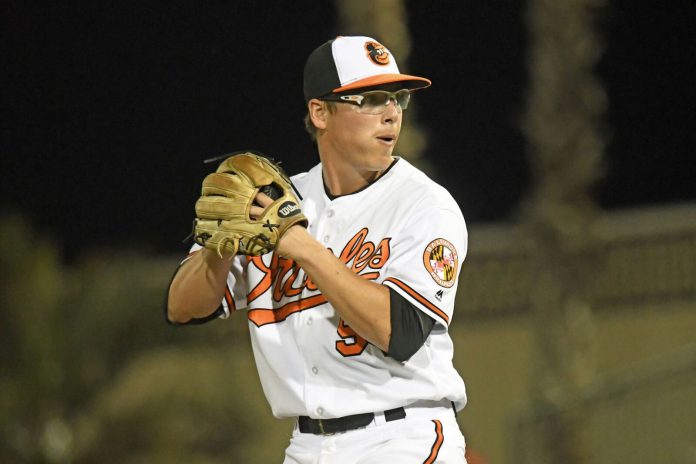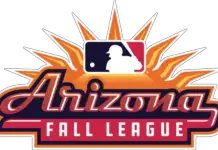- Cleaning out the notebook after watching three Frederick games and one Norfolk game. All games were watched on Milb.tv video from a centerfield camera perspective (similar to MLB games). These are just some scouting notes I made while watching the games. I try not to react to small sample sizes, so I’m not going to comment on every good or bad AB. As the season goes on and I get more data, I’ll have more on approach at the plate, quality of contact, etc. No notes on Bowie or Delmarva because the Delmarva games weren’t televised and the Bowie home games have a terrible camera angle for discerning anything.
Preston Palmeiro
Palmeiro was moved to second base during instructs last fall and the move has stuck. He is the everyday second baseman for the Frederick Keys. He doesn’t look out of place there, he’s an average runner and he’s more athletic than you’d expect. He can make all the routine throws with no problem, but I haven’t seen him really tested yet. He’s comfortable around the bag in limited opportunities and has turned the final portion of 3 double plays in the games I watched. He has made one bad error, literally kicking the ball, but his hands looks fine. He’s still got plenty of work ahead to be an average 2B, but I think it’s well within the realm of possibility.
At the plate, he’s made a ton of contact, with zero strikeouts so far, he’s looked like he has a plan in his ABs.
Alex Wells
Wells pitched 4.1 innings, didn’t have his best stuff or best command, but still made it work. He lacked the feel for the changeup, only throwing a few, all of which were balls out of hand. He did miss more bats than usual though. His curveball isn’t really a swing and miss pitch. It’s too slow and loopy. It generates weak contact well and he can throw it for strikes but it’s not an out pitch. In this outing, Wells showed off a new trick that he used repeatedly to get strikeouts against RHB. He’d throw a curveball for a strike and then follow it with a fastball high and outside, basically taking the track of the curveball if it didn’t break. It worked extremely well and gave him another strategy to protect himself against RHB.
That’s what I like about Wells, if he finds something that works, he has enough consistency and command to repeat it until it stops working.
Cody Sedlock
Sedlock sure looked bad in the first inning, his delivery was stiff, he was failing to finish his pitches, and had trouble throwing strikes. It improved significantly in the second inning, but throughout his outing the mechanics of his delivery were changing. At times he looked like he was throwing with the same deep still arm stab that caused him trouble last season, others he was smooth and on time.
The good new is that all three of his offspeed pitches (FB, SL, CU) flashed 55 (above average) at least once. He also looked healthy and his arm speed was good (it was not last year).
The bad news is that his fastball got barreled frequently, it looked like the hitters were picking up the ball well out of his hand. He was also quite inconsistent mechanically which affected the quality of many of his pitches and his ability to throw strikes.
David Hess
Hess was absolute dealing early, he struck out the top prospect in baseball Ronald Acuna Jr twice on just 7 total pitches. He was mixing a fastball that he spotted well (especially up in the zone for whiffs), a slow curve to get ahead, and a sharp slider with depth that was plus most of the outing. He threw a few changeups but they weren’t generating swings and ended up out of the zone. He ended up striking out 7 and walking none in 5 innings on only 65 pitches.
In the sixth, the issues Hess has had in the past popped up. When he gets hit, he’s an extreme flyball pitcher, so he generally gives up a lot of extra base hits. The first batter was sitting curveball, got one and hit it a mile. The next batter smashed a fastball that saw too much of the plate to the wall for a double. Still, an excellent outing. If Hess carries this type of command consistently he’ll move up in my rankings and be an option for the big league club.
James Teague
The spring training darling is off to a strong start in Frederick. He’s pitched 2 outings, 3 innings total, with 1 hit, 0 runs, 0 BBs, and 5 Ks. He was lights out opening day, locating his fastball well and coming right at hitters. He finished the inning with the best slider I’ve seen from him. I’d have put a 45 (fringe average) on his slider from the spring training outings, but this one was a 60 (plus). In his second outing he was stretched out to two innings. The slider was more 45/50 (fringe average to average), but he located his fastball very well. His command started going in his second inning, but he fought through it.
Ryan McKenna
Really short note, the guy is so fast this year. I’m not sure if he was injured last year, but he looks so much faster now. He tracked down a ball to deep CF, covering an obscene amount of ground. I also clocked him (using a video editor) with a 3.5 second home to first time on a bunt for a base hit. For reference, the fastest ever since Statcast came into existence in the majors was Jose Altuve with 3.33 seconds. McKenna has also run multiple sub-4.10 home to first times on non-bunts as well which is better than 70 speed (plus-plus).
Jomar Reyes
He looks like the top prospect on the field, intimidating presence. Swings viciously, is just missing the ball right now, but just barely. At third base, his arm hides a lot of flaws. It’s a gun and it’s accurate. His range isn’t good, but his hands are fine. He’ll need to improve his footwork and transfer if he wants to stick there. At this point, I think he’s got a better shot than Mountcastle.

























